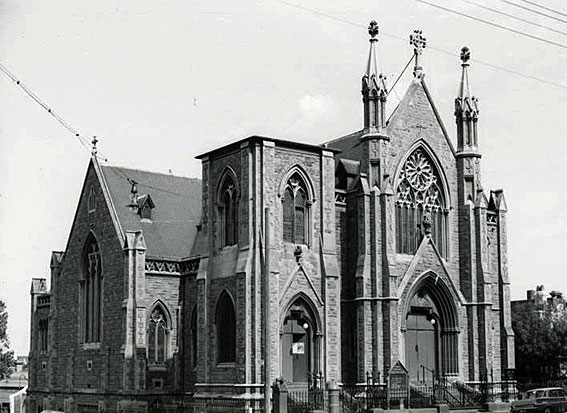
Cairns Memorial Church, East Melbourne: church exterior from north-west (1963)
[Photograph: J.T. Collins Collection, Latrobe Picture Collection, State Library of Victoria]

Cairns Memorial Church, East Melbourne: church exterior from north-west (1963)
[Photograph: J.T. Collins Collection, Latrobe Picture Collection, State Library of Victoria]
Historical and Technical Documentation by John Maidment and Geoffrey Cox
© OHTA, 1982, 2014, 2017 (last updated January 2017)
The foundation stone for the Cairns Memorial Church in East Melbourne was laid on 20 November 1882, and tenders for its erection were called in February 1883 by the original architects, Reed, Henderson and Smart of Melbourne.1
Named in memory of the Rev. Dr. Adam Cairns (1802-1881), late pastor of Chalmers Church on Eastern Hill, this church was intended to accommodate those who had seceded from Chalmers Church and formed themselves into a new charge. The original design for 'a handsome and commodious edifice in the early English Gothic style capable of seating 750 persons' was described and illustrated in The Australasian Sketcher (January 1883). The interior was to be octagonal in form, with the organ and choir placed in the southern transept.2
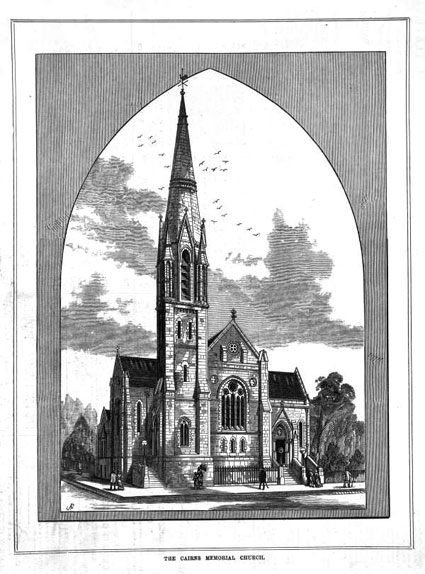
Design by the architects, Reed, Henderson and Smart,
for the proposed Cairns Memorial Church, East Melbourne
[The Australasian Sketcher (17 January 1883), p. 13]
The first portion of the church was opened in November 1883, but was soon found, under the popular ministry of the Rev. G.D. Buchanan, to be too small for the congregation.3
A new design by the architects Twentyman and Askew was developed, and the first part of the redesigned building was opened on 5 October 1884.4 The completed building (without the upper portion of the tower and spire) was opened on 17 April 1887.5 Built from Barrabool Hills stone with Waurn Ponds freestone dressings, it consisted of a nave and transepts, with raking floor, a substantial undercroft and the base of an incomplete tower and spire to the north-west.

Cairns Memorial Church, East Melbourne: drawing of the exterior redesigned by the architects
Twentyman and Askew,
including the projected tower and spire
[Photograph by John Maidment from National Trust of Australia (Victoria) file]
The church was gutted in a disasterous fire in August 1988, after which only the outer walls survived. The gothic shell of the building was incorporated in 1995 into an award-winning apartment complex on the site.

Cairns Memorial Church Apartments
[Photograph from Wikimedia Commons (2007)]
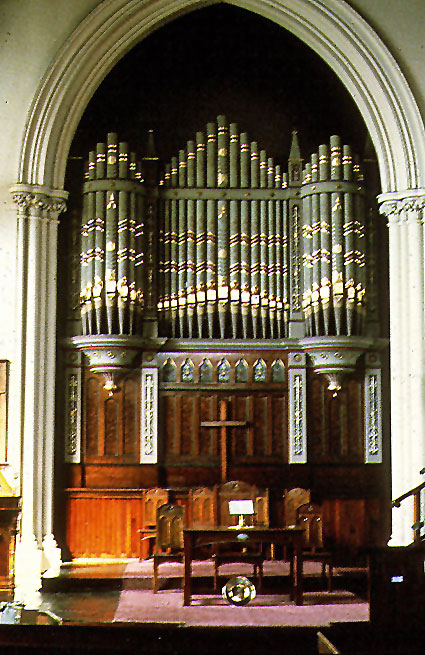
Cairns Memorial Church, East Melbourne: organ
[Photograph by Kelvin Hastie (1982)]
By the time the redesigned church was opened in October 1884, it had been supplied with an organ by Alfred Fuller of Kew, placed in the chancel immediately at the rear of the minister's platform, with the console in front of the pulpit. The Argus of 6 October gave the following description:
The organ contains two manuals, CC to G. The keys are extended in front of the pulpit, about 9ft away, in front, at a very much lower level than the reading desk. In all, the instrument, built by Mr. Fuller, of Kew, has 26 stops of beautiful quality. The reeds throughout are of more than usual excellence, and the solo stops are beautifully voiced and balanced. Supplied with an hydraulic engine, the organ is under the complete control of the organist by an ingenious arrangement, one of the stops having a wind indicator in sight. The console, of polished Italian walnut, has a handsome appearance.6
The Age of the same date gave a more complete description, including the specification:
The organ, built for the church by Mr. Alfred Fuller, of Kew, at a cost of £850, is not only a handsome ornament to the building, but an instrument possessing great sweetness of tone, the reeds being especially good. It has 26 stops in all - 10 in the great organ, 10 in the swell organ and 2 in the pedal organ, the remainder being accessory stops.
GREAT
Open diapason
Viol di gamba
Claribel
Dulciana
Principal
Wald-flute
Twelfth
Fifteenth
Mixture and various
Clarinette and bassoon
8 feet
8 feet
8 feet
8 feet
4 feet
[4 feet]
3 feet
2 feet
8 feet
a new stop, bright and full, with a double quality
SWELL
Double diapason
Violin diapason
Lieblich Gedackt
Keraulophon
Gemshorn
Harmonic piccolo
Sesquialtra
Horn
Oboe
Clarion
Tremulant
16 feet
8 feet
8 feet
8 feet
4 feet
2 feet
3 ranks
8 feet
8 feet
4 feet
PEDAL
Grand open diapason
Bourdon
16 feet
16 feet
COUPLERS
Swell to great
Swell to pedals
Great to pedals
The organ stands on a raised platform behind the pulpit, and the keys are carried forward a distance of 8 feet, thus proving of great advantage to the performer, who is better able to hear and study the effects. The keyboard consists of two manuals in very handsome polished walnut case tastefully carved and covered in by means of a revolving shutter. The bellows are filled by hydraulic power, which is regulated by a few simple turns of a metal handle amongst the stops on the right hand of the player, facing whom there is also a tell tale indicating the quantity of air in the bellows and the pressure required to keep them supplied.7
The organ was opened by Phillip Charles Plaisted (1844-1920), who was engaged as organist by many leading churches in Melbourne, including St Stephen's Anglican Church, Richmond, where he had served over a period of some twenty years:
Mr. Phillip Plaisted, who has accepted the office of organist to the church, conducted the service yesterday, giving, in addition to the usual hymns, Dr. Hopkin's Preludial in A, the Prayer from Lemmen's Storm, and Hallelujah chorus from Handel's Messiah, selections which amply sufficed to show the excellent qualities of the new instrument. Mr. Plaisted, at the close of the morning service, expressed himself highly pleased with the working of the machinery, on which easy manipulation on the part of the performer so largely depends. The organ is a creditable instance of the builder's skill and cannot fail to prove thoroughly satisfactory to the congregation.8
The organ case and the façade pipes were elaborately decorated.
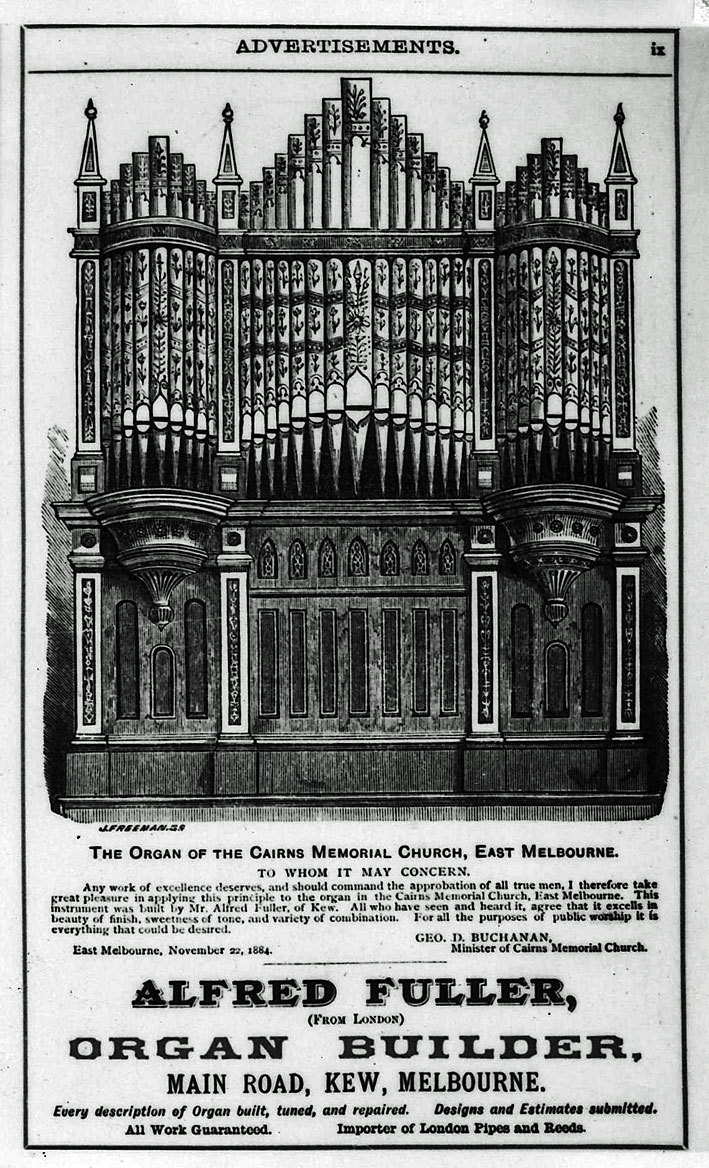
Cairns Memorial Church, East Melbourne: Alfred Fuller advertisement
from Sands & McDougall Directory 1885
[Photograph by John Maidment]
The organ was illustrated in Fuller's advertisement that appeared in a subsequent Sands & McDougall municipal directory for 1885. The casework and tonal design were very similar to the 1883 Fuller organ at St Paul's Anglican Church, Bendigo. It was clearly a sumptuous production in every way.
Graeme Rushworth's assertion that Fuller's case for Cairns Memorial Church was designed by the architect J. Freeman is apparently based on the inscription in the bottom corner of the illustration in the Sands & McDougall directory.9 James Freeman, however, was an artist and wood engraver, not an architect.10 As the casework at St Paul's, Bendigo, was described as coming 'from the pencil of the builder',11 it can be assumed that Fuller designed both the Bendigo and East Melbourne cases.

Cairns Memorial Church, East Melbourne: organ from rear gallery
[Photograph from Uniting Church Archives, Elsternwick, Vic]
In 1949, the organ was rebuilt by Hill, Norman & Beard (Australia) Pty Ltd (job number V227). Electro-pneumatic action was installed together with a detached stop-key console located in the left transept. This enabled the sanctuary area to be rearranged. The specification of the organ was not significantly altered, although a Vox Angelica was prepared-for on the Swell; several Pedal stops were extended from the original two; the manual compass was extended from 56 to 61 notes; and there was some minor renaming of stops.
| GREAT Open Diapason Viola Claribel Flute Dulciana Principal Wald Flute Twelfth Fifteenth Mixture 19.22 Clarinet Swell Sub Octave to Great Swell to Great Swell Octave to Great SWELL Lieblich Bourdon Open Diapason Lieblich Gedackt Salicional Vox Angelica Gemshorn Piccolo Sesquialtera 17.19.22 Horn Oboe Clarion Tremulant Sub Octave Unison Off Octave PEDAL Open Diapason Bourdon Octave Flute Octave Flute Great to Pedal Swell to Pedal |
8 8 8 8 4 4 2-2/3 2 II 8 16 8 8 8 8 4 2 III 8 8 4 16 16 8 8 4 |
stopped wood with Bassoon bass TC prepared for A wood B A B B |
Compass: 61/30
Thumb & toe pistons
Balanced swell pedal
Electro-pneumatic key and stop action
Detached stop-key console.12
The organ was destroyed along with the interior of the church in the fire of August 1988.
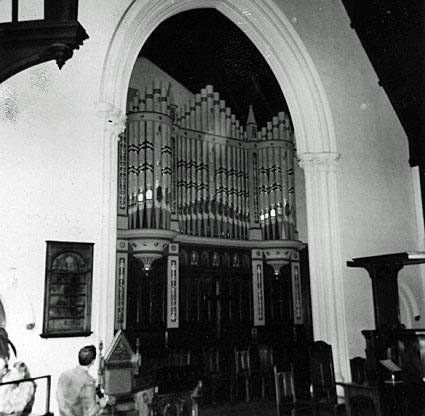
Cairns Memorial Church, East Melbourne: organ
[photograph by W.G.S. Smith (c.1970)]
1 The Argus (21 November 1882), p. 4; The Argus (12 February 1883), p. 3.
2 The Australasian Sketcher (17 January 1883), p. 6.
3 The Argus (18 April 1887), p. 7.
4 The Argus (6 October 1884), p. 3; The Age (6 October 1884), p. 5.
5 The Argus (18 April 1887), p. 7.
6 The Argus (6 October 1884), p. 3.
7 The Age (6 October 1884), p. 5.
8 Loc. cit.
9 Graeme Rushworth, 'Alfred Fuller, Melbourne 19th century organ builder – his life and work,' OHTA News, vol. 6, no. 4 (October 1982), pp. 3-19, cited at http://www.ohta.org.au/doc/articles/afuller.html
10 The Argus (2 May 1883), p. 9; The Age (2 May 1883), p. 5.
11 'St. Paul's Church Organ,' The Bendigo Advertiser (23 April 1883), p. 2.
12 Specification noted by John Maidment, 1966.